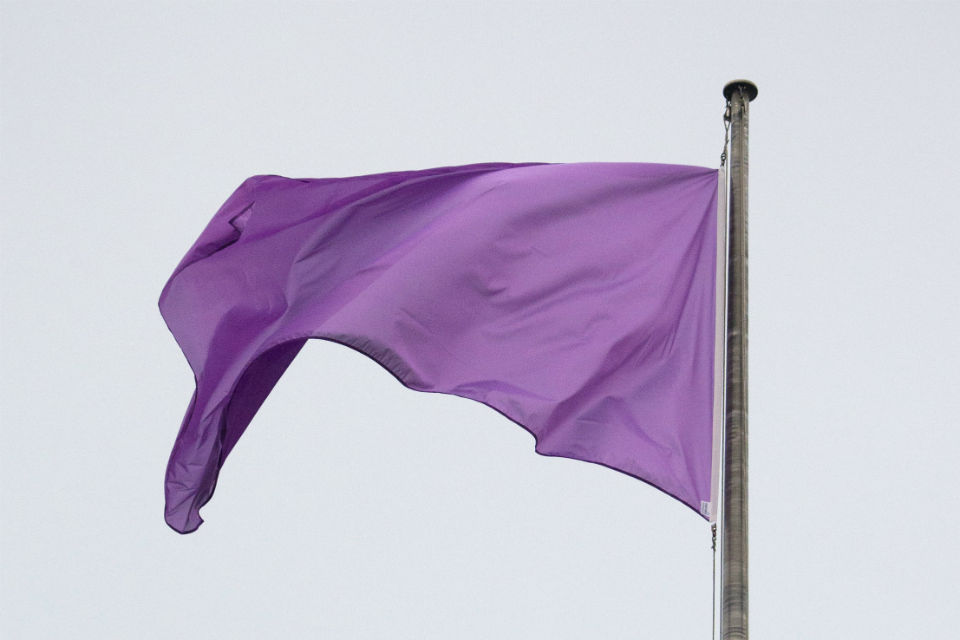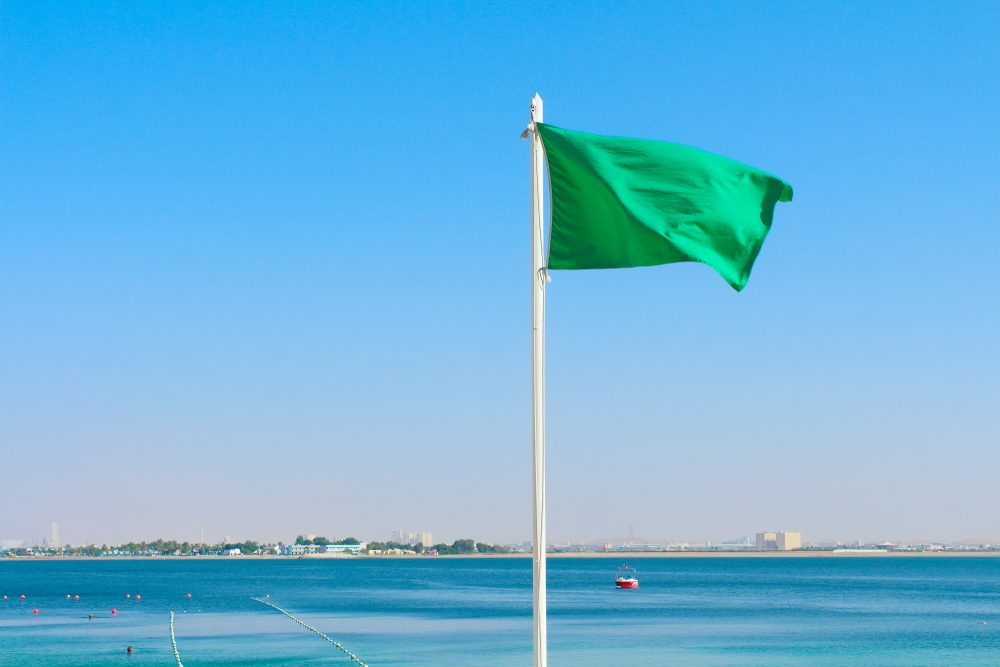As someone who absolutely adores the beach, I’ve spent countless hours soaking up the sun, building sandcastles, and diving into the waves. There’s something magical about the salty breeze, the soothing sound of the waves crashing, and the feeling of warm sand between your toes that brings a sense of peace and pure joy. But amidst all the fun and relaxation, I stumbled upon a curious sight that I hadn’t encountered before—the mysterious purple flag waving at the shoreline.

We’re all familiar with the standard beach flags: green signals calm waters, yellow indicates caution, and red warns of dangerous conditions. Each color carries a specific meaning, a language every beach lover should know. But what does the purple flag represent? If you’ve ever spotted one fluttering in the breeze, you may have been as confused as I was. As it turns out, the purple flag has a critical and surprising message for beachgoers.
The Purple Flag: A Warning of Marine Pests
Picture this: it’s a perfect beach day. The sun is shining, the waves are gentle, and you’re ready to jump into the water. You scan the beach flags to check the conditions—green for calm, yellow for caution, red for danger. Then, suddenly, you see it—the purple flag. What could it mean?
After a little investigation, I discovered that the purple flag is a warning of marine pests. Yes, that’s right, it signals the presence of potentially dangerous creatures in the water, such as jellyfish, stingrays, or other harmful marine life. The ocean, through this flag, is essentially giving us a heads-up: “Enjoy the water, but be aware, there might be some uninvited guests.”
Understanding Marine Pests: Jellyfish, Stingrays, and More
Marine pests can range from harmless to dangerous, and knowing what to expect when the purple flag is flying is important for every beachgoer.
- Jellyfish: These fascinating yet often stinging creatures are one of the most common marine pests that the purple flag warns about. While some jellyfish stings are mild, others can be more painful and require medical attention, especially in areas known for species like the Portuguese Man o’ War.
- Stingrays: Stingrays can usually be found resting on the sandy ocean floor, blending in with their surroundings. Accidentally stepping on one can lead to a painful sting from their barbed tail. If the purple flag is up, it’s a good idea to shuffle your feet through the sand instead of walking, giving the stingrays a chance to swim away.
- Other Dangerous Fish: Occasionally, the purple flag may also signal the presence of other marine creatures, such as certain types of fish with sharp spines or venomous barbs. It’s always a good idea to ask a lifeguard about the specific hazards when you see the purple flag.
Why the Purple Flag Matters
At first glance, the purple flag might seem like just another piece of beach decor, but in reality, it serves a vital function in protecting beachgoers. Marine pests are a natural part of the ocean’s ecosystem, but they can pose risks to those enjoying the water. The purple flag is the ocean’s way of saying, “Hey, it’s beautiful out here, but watch out for what’s beneath the surface.”

Understanding what this flag represents allows you to make informed decisions about whether to swim or stay on the shore. It’s important to respect the warning, especially when conditions might seem perfect otherwise. A calm ocean doesn’t always mean it’s safe to swim—sometimes it’s what’s under the water that you need to watch out for.
How the Purple Flag Fits Into Beach Safety
Like the other flags used at beaches, the purple flag plays a crucial role in ensuring the safety of visitors. Knowing the meanings behind the beach flag system can help you enjoy the water while minimizing risks.

- Green Flag: A green flag indicates calm waters and low hazards. This is the perfect time to take a leisurely swim and enjoy the gentle waves.
- Yellow Flag: A yellow flag warns of moderate hazards, such as stronger waves or currents. Proceed with caution, especially if you’re not a strong swimmer.
- Red Flag: A red flag signifies high hazards, such as rough waters or strong currents. Swimming in these conditions is dangerous, and it’s recommended to stay out of the water unless you’re a very experienced swimmer.
- Double Red Flag: This is the ultimate warning—water is closed to the public. When you see two red flags, it means conditions are too dangerous for anyone to enter the water.
In this lineup of warnings, the purple flag adds an important layer of information: it’s not about the conditions of the water, but rather what’s living in it. Jellyfish and stingrays don’t care if the sea is calm or rough—they’re there regardless. That’s why paying attention to the purple flag is just as crucial as watching for red or yellow flags.
Beach Etiquette and Safety: Respect the Ocean’s Message
The beach is a beautiful, dynamic environment, and part of what makes it so special is the balance between relaxation and respect for nature. The purple flag is a reminder that we share the ocean with marine life, some of which can pose risks to our safety.
As beach lovers, it’s essential to heed the warnings these flags provide. By understanding the meaning of the purple flag, we can coexist safely with the marine creatures that call the ocean home. So, the next time you spot that mysterious purple flag, don’t just brush it off as another beach accessory. Take a moment to appreciate the ocean’s quiet communication—it’s inviting you to enjoy the waves but with awareness and caution.
What To Do If You Encounter a Marine Pest

If you happen to swim in waters where the purple flag is flying, and you encounter a marine pest like a jellyfish or stingray, here are a few safety tips:
- For Jellyfish Stings: If you’re stung by a jellyfish, rinse the area with saltwater—freshwater can make the sting worse. Applying vinegar may help deactivate the stingers, and in some cases, applying heat can ease the pain. Always seek medical attention if the sting is severe or if you experience symptoms like difficulty breathing.
- For Stingray Stings: If stung by a stingray, soak the affected area in hot water (not scalding) to ease the pain and reduce venom potency. Seek medical attention, as stingray wounds can become infected.
- Always Be Informed: Ask lifeguards about any current marine hazards. They are a valuable resource and can provide up-to-date information on any risks you should be aware of.
Conclusion: Embrace the Ocean’s Message
The purple flag at the beach is no longer a mystery—it’s a vital part of beach safety that informs us about potential marine pests in the water. As much as we love basking in the sun and swimming in the sea, it’s important to remain aware of the hidden world beneath the waves. The next time you see a purple flag waving in the breeze, remember that it’s the ocean’s way of saying, “Come enjoy, but be aware of what’s swimming with you.”
With a little caution and respect for the ocean’s inhabitants, we can continue to enjoy beach days while keeping ourselves and the marine ecosystem safe. So, grab your sunscreen, pack your beach bag, and head to the shore with a newfound understanding of the purple flag and its crucial role in your beach experience.